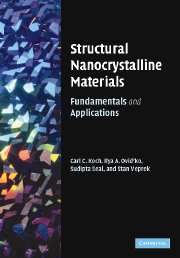Book contents
- Frontmatter
- Contents
- Preface
- Acknowledgments
- 1 Introduction
- 2 Processing of structural nanocrystalline materials
- 3 Stability of structural nanocrystalline materials – grain growth
- 4 Mechanical properties of structural nanocrystalline materials – experimental observations
- 5 Mechanical properties of structural nanocrystalline materials – theory and simulations
- 6 Corrosion of structural nanomaterials
- 7 Applications of structural nanomaterials
- Index
- References
5 - Mechanical properties of structural nanocrystalline materials – theory and simulations
Published online by Cambridge University Press: 04 December 2009
- Frontmatter
- Contents
- Preface
- Acknowledgments
- 1 Introduction
- 2 Processing of structural nanocrystalline materials
- 3 Stability of structural nanocrystalline materials – grain growth
- 4 Mechanical properties of structural nanocrystalline materials – experimental observations
- 5 Mechanical properties of structural nanocrystalline materials – theory and simulations
- 6 Corrosion of structural nanomaterials
- 7 Applications of structural nanomaterials
- Index
- References
Summary
Introduction
The rapidly growing scientific and technological interest in structural nanocrystalline bulk materials and coatings arises from their outstanding mechanical properties opening a range of new applications; see, for example, reviews (Koch et al., 1999; Gleiter, 2000; Gutkin et al., 2001; Mohamed and Li, 2001; Padmanabhan, 2001; Veprek and Argon, 2002; Kumar et al., 2003a; Milligan, 2003; Ovid'ko, 2004; Valiev, 2004; Chokshi and Kottada, 2006; Han et al., 2005; Ovid'ko, 2005a, b; Wolf et al., 2005) and books (Roco et al., 2000; Chow et al., 2000; Farkas et al., 2001; Berndt et al., 2003; Komarneni et al., 2003; Gutkin and Ovid'ko, 2004a). These outstanding mechanical properties are caused by the interface and nanoscale effects associated with structural peculiarities of nanocrystalline materials where the volume fraction of the interfacial phase is extremely high, and grain size d does not exceed 100 nm. For instance, nanocrystalline bulk materials and coatings often exhibit extremely high strength, superhardness and good fatigue resistance desired for numerous applications; see Chapter 4 and the literature (Siegel and Fougere, 1995; Hahn and Padmanabhan, 1995; Koch et al., 1999; Gleiter, 2000; Gutkin et al., 2001; Mohamed and Li, 2001; Niederhofer et al., 2001; Padmanabhan, 2001; Veprek and Argon, 2002; Kumar et al., 2003a; Milligan, 2003; Patscheider, 2003; Valiev, 2004; Chokshi and Kottada, 2006; Han et al., 2005; Ovid'ko, 2005a, b; Wolf et al., 2005). At the same time, in most cases, nanocrystalline materials show low tensile ductility at room temperature, which essentially limits their practical utility.
Information
- Type
- Chapter
- Information
- Structural Nanocrystalline MaterialsFundamentals and Applications, pp. 204 - 316Publisher: Cambridge University PressPrint publication year: 2007
